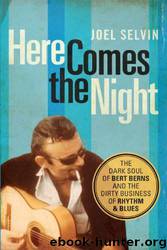Here Comes the Night: The Dark Soul of Bert Berns and the Dirty Business of Rhythm and Blues by Joel Selvin

Author:Joel Selvin
Language: eng
Format: mobi
Tags: History & Criticism, Music
ISBN: 9781619023789
Publisher: Counterpoint
Published: 2014-04-15T00:00:00+00:00
* Billboard Hot 100 Top Five, week of August 15, 1964: 1. “Where Did Our Love Go” by the Supremes; 2. “Everybody Loves Somebody” by Dean Martin; 3. “A Hard Day’s Night” by the Beatles; 4. “Under the Boardwalk” by the Drifters; 5. “The House of the Rising Sun” by the Animals.
XIV.
Here Comes the Night [1964]
THE BRITISH INCURSION on the American pop charts led by the Beatles that January, 1964 was so intense and unexpected that it swept away all before it. Even Wexler bowed down. Only a year before, he sent Paul Marshall away when his general counsel showed up wanting to give him the new Beatles records. Wexler now eagerly licensed an ancient recording of the Beatles, cut three years earlier in Germany when the band was hired to back British expatriate vocalist Tony Sheridan. He released the one track featuring John Lennon on vocals, the Jazz Age chestnut “Ain’t She Sweet,” and floated the single into the Top Twenty. British records suddenly suffused the American hit parade. The year before, there were none. The next year, somewhere between one-quarter and one-third of the big hits in this country were British.
Although British culture had been making inroads on the American scene over the previous few years on the Broadway stage and in movie theaters, nothing in those early signs suggested that British pop music would swell up out of London and become the single most significant trend in the American pop music marketplace since the original introduction of rock and roll ten years before. These guitar-playing British art school dropouts were practicing a distinctly American form of music, echoes of a raucous din first raised in the faraway former colonies, colored by the working-class, underdog, disaffected sensibilities of these British youth, oddly enough, not greatly unlike their counterparts in the American social substrata, the black musicians who made much of the original music in the first place. On levels they didn’t even understand, these Brits connected with the American blacks.
Separated by geography, history, and culture, the postwar British public saw American life as exotic and adventuresome. American racial issues meant little in England, so that element of the music was absent from their understanding. It was all music from darkest America. The rank consumerism of America shocked and fascinated an England still recovering from the deprivations of war. In the austere, repressive British culture of the day, the carefree rebelliousness implicit in rock and roll stirred unimaginable emotions in young British musicians.
While some of the English enthusiasts were attracted to even more subterranean American musical currents represented by vernacular blues artists such as John Lee Hooker or Jimmy Reed—British audiences had been exposed to that fundamental music since midfifties performances by Chicago bluesmen Big Bill Broonzy, Memphis Slim, Muddy Waters, and a subsequent procession of others—most of these British pop upstarts drew their clearest inspirations from the New York rhythm and blues scene. Lennon and McCartney really just wanted to be Goffin and King.
Mickie Most was the twenty-six-year-old
Download
This site does not store any files on its server. We only index and link to content provided by other sites. Please contact the content providers to delete copyright contents if any and email us, we'll remove relevant links or contents immediately.
| Classical | Country & Folk |
| Heavy Metal | Jazz |
| Pop | Punk |
| Rap & Hip-Hop | Rhythm & Blues |
| Rock |
Cecilia; Or, Memoirs of an Heiress — Volume 2 by Fanny Burney(31871)
Cecilia; Or, Memoirs of an Heiress — Volume 3 by Fanny Burney(31856)
Fanny Burney by Claire Harman(26526)
We're Going to Need More Wine by Gabrielle Union(18967)
Plagued by Fire by Paul Hendrickson(17331)
All the Missing Girls by Megan Miranda(15573)
Cat's cradle by Kurt Vonnegut(15185)
Bombshells: Glamour Girls of a Lifetime by Sullivan Steve(13975)
Leonardo da Vinci by Walter Isaacson(13182)
For the Love of Europe by Rick Steves(13000)
4 3 2 1: A Novel by Paul Auster(12284)
Adultolescence by Gabbie Hanna(8857)
The remains of the day by Kazuo Ishiguro(8822)
Note to Self by Connor Franta(7621)
Diary of a Player by Brad Paisley(7487)
Giovanni's Room by James Baldwin(7192)
What Does This Button Do? by Bruce Dickinson(6135)
Born a Crime by Trevor Noah(5295)
Ego Is the Enemy by Ryan Holiday(5294)
